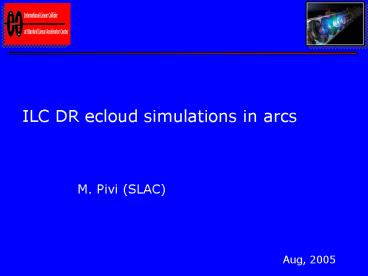ILC DR ecloud simulations in arcs PowerPoint PPT Presentation
1 / 17
Title: ILC DR ecloud simulations in arcs
1
ILC DR ecloud simulations in arcs
M. Pivi (SLAC)
Aug, 2005
2
ILC Damping Ring electron cloud studies and
simulations
- At the end of the year 2005, a Damping Ring (DR)
will be selected amongst the actual 7 different
damping ring designs. Goal of the DR task force 6
is to evaluate the electron cloud effect in each
damping ring circumference range (17km, 6km,
3km). - We prioritize simulations starting to focus on
the three DR designs TESLA 17km, OCS 6km, OTW
3km. Hopefully we will reach the
point to simulate the remaining DRs. - Started benchmarking the electron cloud build-up
with codes ECLOUD (CERN) and POSINST (SLAC). - Use common secondary electron yield (SEY)
model/s. Sensitivity studies. - Single-bunch instability simulations KEK/CERN
3
News
- A. Wolski suggested to use new specifications for
vacuum camber sizes. This vacuum chamber sizes
are actually adopted by the rest of task force
community, and are listed in the paper - http//www.desy.de/awolski/ILCDR/DRConfiguration
Study_files/Task3_files/ILCDRVacuum.pdf - chamber sizes are smaller than previous TESLA
specifications. - concern more electron cloud with smaller
chamber size ? (see simulations below) - Probably, that is ok for comparative studies
(?!)
4
ILC DR Parameters vacuum chamber (new)
http//www.desy.de/awolski/ILCDR/DRConfigurationS
tudy_files/Task3_files/ILCDRVacuum.pdf
Arc chamber
Wiggler chamber
5
ILC DR Parameter
Updated parameters table file on web, with new
vacuum chamber parameters and corrected beam
sizes.
6
SEY Models
Secondary Emission Yield Model 1) (variable Emax
and variable e- reflectivity extrapolation
based on LHC Proj.Rep-632, SPS
measurements SR (?!) electron
conditioning) delta_max 1.3 epsilon_max Emax
190 eV (function of delta_max) low-energy
elastic reflectivity of electrons at 1.3
35 delta_max 1.2 epsilon_max Emax 180 eV
(function of delta_max) low-energy elastic
reflectivity of electrons at 1.2 33 delta_max
1.1 epsilon_max Emax 170 eV (function of
delta_max) low-energy elastic reflectivity of
electrons at 1.1 30
Secondary Emission Yield Model 2) (constant Emax
and constant e- reflectivity based on SPS data
and. Hillerets recommendation) delta_max
1.3 epsilon_max Emax 234.75 eV (function of
delta_max) low-energy elastic reflectivity of
electrons at 1.3 50 delta_max 1.2 epsilon_max
Emax 232.38 eV (function of delta_max)
low-energy elastic reflectivity of electrons at
1.2 50 delta_max 1.1 epsilon_max Emax 230 eV
(function of delta_max) low-energy elastic
reflectivity of electrons at 1.1 50
7
ILC DR Parameter
8
TESLA COMPARE SEY MODELS
arc BEND
arc BEND
SEY MODEL (2)
SEY MODEL (1)
Using POSINST
9
OCS DR arc BEND
Threshold at SEY1.2
10
OTW DR arc BEND
peak SEY1.0
Threshold at SEYlt1.0. (Electrons spiral in bend
and impinge with a grazing angle increasing the
effective SEY).
11
TESLA DR arc DRIFTs
Photoelectrons dominated.
POSINST
12
OCS and OTW arc DRIFTs
Clear build-up in OTW
13
Compare different chamber sizes
Smaller vacuum chamber radius beneficial in all
configurations.
14
Compare in DRs ARC
BEND
arc DRIFT
15
OTW density within 10 beam sigma, pinghing effect
End bunch passage
Density before bunch passage
Factor 3-4 pinching
16
Electron-cloud thresholds in BENDS of different
rings.
17
- SEY MODEL 1 and 2 close results in this
parameter range. - TESLA has moderate electron cloud build-up in
BENDS and is dominated by photoelectrons in arc
drifts - OTW has threshold SEYlt1 in bends and clear
build-up in drifts - Need ARC quadrupoles and wiggler simulations, to
compile electron cloud density along all ring. - Computing short-range wake fields
The deadline is end of October

